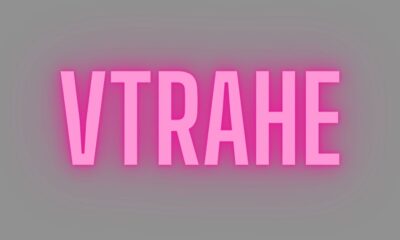Education
The Ultimate Guide to Online Schools: Everything You Need to Know

Are you ready to take your education to the next level? Online schools offer a flexible and convenient way to pursue your academic goals without sacrificing your other commitments. Whether you’re looking to advance in your career, switch professions, or simply expand your knowledge, online schools provide a wealth of opportunities at your fingertips. In this ultimate guide, we’ll delve into everything you need to know about online schools – from choosing the right one for you to navigating admissions and financial aid. Let’s embark on this educational journey together!
Choosing the Right Online School
When it comes to choosing the right online school, it’s essential to consider factors such as program offerings, accreditation, and support services. Start by researching schools that align with your academic and career goals. Look for programs that are accredited by recognized agencies to ensure quality education. Consider the flexibility of course schedules and how well they fit into your life commitments.
Additionally, explore the support services offered by each online school. From academic advising to technical assistance, having access to resources can greatly impact your success as an online student. Take the time to read reviews and testimonials from current or former students to get a sense of their experiences with the school.
Finding the right online school is about finding a balance between academic quality, support services, and personal fit. Trust your instincts and choose a school that resonates with you on both an educational and personal level.
Academic Quality and Accreditation
When considering online schools, one crucial factor to examine is academic quality and accreditation. Accreditation ensures that the institution meets certain standards of excellence in education. It signifies that the school has undergone a rigorous evaluation process by an accrediting body.
Attending an accredited online school guarantees that your degree will be recognized by employers and other institutions, giving you credibility in the job market. Academic quality goes hand in hand with accreditation, indicating that the programs offered are up to par with industry standards.
Online schools with strong academic quality often have qualified faculty members who are experts in their fields. They provide students with a well-rounded education and valuable skills for their chosen careers. Before enrolling in any online program, it’s essential to research the accreditation status of the school to ensure you’re investing your time and resources wisely.
Program Finder and Course Offerings
When it comes to choosing the right online school, exploring their program finder and course offerings is key. Online schools typically offer a wide range of programs spanning various fields of study, from business and healthcare to technology and education.
The program finder tool allows prospective students to search for specific programs based on their interests, career goals, or desired level of education. This feature makes it easier for individuals to narrow down their options and find a program that aligns with their aspirations.
Course offerings may include core curriculum requirements as well as specialized electives within each program. These courses are designed to provide students with a comprehensive education in their chosen field and equip them with the knowledge and skills needed to succeed in the workforce.
Additionally, online schools often update their course offerings to reflect industry trends and advancements, ensuring that students receive relevant and up-to-date instruction throughout their academic journey. So, take advantage of the program finder tool when researching online schools – you might just discover the perfect fit for your educational pursuits!
Admissions and Financial Aid
Navigating the admissions process for online schools can seem daunting at first, but rest assured that there are resources available to guide you every step of the way. From filling out applications to submitting transcripts, each school has its own set of requirements, so it’s essential to carefully review and meet all deadlines.
Financial aid is a crucial aspect of pursuing higher education, and online schools offer various options to help make your academic dreams a reality. Scholarships, grants, loans, and work-study programs are just some of the avenues you can explore to offset tuition costs. Be sure to research each opportunity thoroughly and apply early for maximum consideration.
Don’t hesitate to reach out to the admissions office or financial aid department if you have questions or need assistance throughout the process. Online schools are committed to helping students succeed academically while managing their financial responsibilities effectively.
Support Services for Students
Online schools offer a range of support services to ensure student success. From academic advising to technical assistance, these resources are designed to help students navigate their online learning experience smoothly.
One key support service is access to virtual tutoring and writing centers. These resources provide personalized help for students who may need extra assistance in specific subjects or improving their writing skills.
Additionally, online schools often have dedicated career services departments that assist students with resume building, job searching, and interview preparation. This can be invaluable for those looking to advance their careers or enter the workforce after graduation.
Moreover, mental health counseling services are increasingly available at online schools. Addressing the emotional well-being of students is essential for overall academic success and personal growth.
Having robust support services in place can make a significant difference in helping students thrive in an online learning environment.
Military-Friendly Schools
When it comes to choosing an online school, military-friendly institutions play a crucial role in supporting service members and their families. These schools understand the unique challenges that military personnel face, such as deployments and relocations, and offer flexible programs to accommodate their needs.
Military-friendly schools often provide dedicated support services tailored specifically for veterans and active-duty members, including assistance with benefits like GI Bill® eligibility and tuition assistance programs. This extra level of care ensures that those who have served our country can pursue their educational goals seamlessly.
Moreover, these institutions may have specialized advisors who are well-versed in military-related issues and can guide students through the academic journey while considering their specific circumstances. From navigating course schedules to understanding transfer credits from previous military training, these advisors go above and beyond to make the transition into higher education smoother for military-affiliated individuals.
By prioritizing the needs of those who have served or are currently serving in the armed forces, military-friendly schools create a supportive learning environment that fosters success among this unique student population.
Student Success Stories and Alumni Testimonials
Embarking on the journey of online education can lead to remarkable success stories and inspiring alumni testimonials. These narratives showcase the real impact that online schools have had on individuals’ lives, careers, and futures.
From balancing work, family commitments, and education to overcoming challenges with determination and resilience, these stories depict the dedication and hard work that go into achieving academic goals through online learning platforms.
Alumni testimonials often highlight how the flexibility of online programs allowed them to pursue their dreams while maintaining their personal responsibilities. They speak to the transformative power of education and how it opens doors to opportunities previously thought out of reach.
These success stories serve as beacons of motivation for current students, showing them that with perseverance and support from their online school community, they too can achieve their aspirations.
Connecting with Online Schools: Contact Information
In the digital age, connecting with online schools is easier than ever. Whether you have a question about a specific program or need assistance with the admissions process, having access to the right contact information is crucial.
Most online schools provide multiple channels for communication, including email addresses, phone numbers, and even live chat options on their websites. This allows prospective students to reach out and get the information they need quickly and conveniently.
When reaching out to online schools through contact information provided, it’s important to be clear about your inquiries and goals. This will help school representatives assist you more effectively and efficiently.
By taking advantage of the contact information available from online schools, you can ensure that you are well-informed and supported throughout your academic journey. So don’t hesitate to reach out – help is just an email or call away!
Tailoring Your Education to Match Your Goals
Are you considering online schools but unsure how to align your education with your goals? Tailoring your education to match your aspirations is crucial for success. Start by identifying what you want to achieve – whether it’s advancing in your career, switching fields, or pursuing a passion.
Research different programs offered by online schools that cater to your interests and future plans. Look for courses that provide the knowledge and skills needed to reach your objectives effectively. Don’t hesitate to reach out to academic advisors at online schools for guidance on selecting the right path.
Consider the flexibility of online learning when tailoring your education – it allows you to study at your own pace while balancing other commitments. Take advantage of resources provided by online schools such as virtual libraries, tutoring services, and networking opportunities tailored towards helping you achieve success in line with your goals.
By customizing your educational journey through an online school, you can ensure that every step taken brings you closer to realizing your dreams and aspirations.
Balancing Education with Life Commitments
Balancing education with life commitments can be a challenging juggling act. Whether you’re working full-time, taking care of family, or managing other responsibilities, finding time for studying can seem overwhelming. However, online schools offer flexibility that traditional brick-and-mortar institutions may not provide.
By choosing an online school, you have the freedom to create your own schedule and study at your own pace. This means you can attend classes when it’s most convenient for you – whether that’s early in the morning before work or late at night after putting the kids to bed.
Additionally, online schools often offer asynchronous learning opportunities, allowing you to access course materials and lectures whenever it fits best into your busy day. This flexibility enables you to pursue your educational goals without sacrificing other important aspects of your life.
Remember that finding balance is key. It’s essential to prioritize tasks effectively, set realistic goals, and communicate openly with professors or advisors if you need support along the way. With dedication and proper time management skills, achieving a harmonious blend between education and personal commitments is definitely within reach when attending an online school.
Accelerating Career Growth through Education
Looking to fast-track your career advancement? Pursuing further education through online schools can be the key to accelerating your professional growth. By earning a degree or certificate in your field of interest, you demonstrate commitment and expertise that can set you apart from others in the competitive job market.
Online programs offer flexibility, allowing you to balance work and studies seamlessly. This means you can continue gaining practical experience while enhancing your skills and knowledge simultaneously. The convenience of online learning allows for self-paced study, enabling you to tailor your education around your existing commitments.
Moreover, acquiring advanced qualifications demonstrates initiative and dedication to potential employers. It showcases a willingness to learn and adapt, qualities that are highly valued in today’s rapidly evolving job landscape. With specialized training from online schools, you can position yourself as a top candidate for promotions or new opportunities within your industry.
Take charge of your career trajectory by investing in continuous education through reputable online institutions. Stay ahead of the curve by honing your expertise and expanding your professional network through virtual learning platforms tailored to suit busy professionals like yourself.
Opportunities for Military Students
For military students considering online schools, there are unique opportunities tailored to their specific needs and commitments. Many online institutions offer flexible schedules, allowing active-duty service members to complete coursework around their deployments or training obligations. This flexibility is crucial for those juggling military duties with academic pursuits.
Additionally, some online schools provide specialized support services for military students, such as dedicated advisors who understand the challenges faced by those in the armed forces. These resources can help navigate the complexities of balancing military responsibilities with educational goals.
Furthermore, many online schools have partnerships with military branches or participate in programs like the Yellow Ribbon Program to provide financial assistance beyond GI Bill benefits. These collaborations make pursuing higher education more accessible and affordable for servicemembers and veterans alike.
Online schools present valuable opportunities for military students seeking to advance their education while serving their country dutifully.
The Online Learning Environment and Supportive Resources
Online schools provide a dynamic learning environment that caters to diverse student needs. With easy access to course materials and interactive platforms, online learning offers flexibility for students balancing work and family commitments.
Supportive resources such as virtual libraries, online tutoring services, and discussion forums enhance the educational experience by fostering collaboration among peers. Students can engage with professors through email or video conferencing, ensuring personalized guidance throughout their academic journey.
The digital nature of online education promotes self-discipline and time management skills essential for success in today’s fast-paced world. Additionally, tech-savvy tools like mobile apps and webinars make learning convenient and engaging for students of all backgrounds.
By offering a range of supportive resources within a flexible learning environment, online schools empower students to achieve their academic goals while navigating the demands of daily life seamlessly.
Understanding Tuition, Fees, and Scholarships
When considering online schools, understanding tuition, fees, and scholarships is crucial. Tuition costs can vary depending on the school and program you choose. Some online schools offer competitive rates compared to traditional universities, making higher education more accessible.
Fees can also add up, so it’s essential to inquire about any additional costs beyond tuition. These fees could include technology fees or course material expenses. Being aware of these extra charges upfront can help you budget accordingly.
Scholarships are a valuable resource for students looking to offset the cost of their education. Many online schools offer various scholarship opportunities based on academic merit, financial need, or specific criteria related to the program.
By researching tuition rates, identifying potential fees, and exploring scholarship options, you can make informed decisions about your educational investment in an online school setting.
Transitioning to an Online Learning Environment
Transitioning to an online learning environment can be a transformative experience, offering flexibility and convenience while still providing a quality education. By understanding the ins and outs of online schools, you can make informed decisions that align with your goals and lifestyle. Whether you are pursuing further education for career advancement, personal growth, or military service requirements, online schools offer a wealth of opportunities.
Embrace the digital age of learning and take advantage of the resources available to you through online schools. With dedication, support services tailored to online students’ needs, and a commitment to success, you can thrive in this dynamic educational setting. Start your journey towards academic achievement today by exploring the diverse options that online schools have to offer – the possibilities are endless!
Education
reader response journal middle school

A reader response journal in middle school is a tool used to help students actively engage with the texts they read. It encourages personal connections, critical thinking, and emotional reactions by allowing students to write their reflections and opinions in response to reading assignments. Unlike traditional book reports or comprehension quizzes, reader response journals are informal and focus on the student’s perspective rather than just right or wrong answers.
Students might write about what they liked or didn’t like in a story, make predictions, analyze characters, or relate the book to their own experiences. This personal connection deepens understanding and fosters a love for reading.
Why Reader Response Journals Matter for Middle School Students
Middle school is a crucial stage in literacy development. Students are transitioning from learning to read to reading to learn. Reader response journals support this transition by:
Encouraging deeper engagement with texts
Improving comprehension through personal reflection
Allowing freedom of thought and expression
Promoting empathy by connecting with characters
Helping teachers assess understanding beyond standard tests
When students feel their voice matters in interpreting literature, they become more motivated readers and more confident writers.
Key Elements of an Effective Reader Response Journal
To maximize the educational value of reader response journals, certain key elements should be included:
Consistent Entries: Journals should be maintained regularly to track progression and growth in reading comprehension.
Prompts and Questions: These guide students to think critically about the text and offer structure for their reflections.
Textual Evidence: Encouraging students to cite specific passages helps support their ideas and fosters analytical thinking.
Personal Connection: Students should be free to relate stories to their lives, which makes reading meaningful and memorable.
Creativity: Drawings, poems, alternate endings, and letters to characters can make journaling more enjoyable and engaging.
These components help middle schoolers explore literature with depth and confidence.
Best Prompts to Use in Reader Response Journals
To keep students interested and push their thinking, using varied and thought-provoking prompts is key. Here are some types of prompts that work well:
Prediction: What do you think will happen next and why?
Character Analysis: Which character do you relate to and why?
Theme Exploration: What is the central theme? How is it relevant to your life?
Author’s Purpose: Why do you think the author wrote this story?
Personal Reflection: Has this story ever happened to you or someone you know?
Conflict and Resolution: What was the main conflict, and how was it resolved?
Opinion-Based: Do you agree with the character’s decisions?
Changing prompts often keeps the activity fresh and stimulates varied critical thinking.
How Reader Response Journals Support Reading Comprehension
Comprehension goes beyond simply understanding the plot. Reader response journals help middle schoolers:
Process Events and Character Motivation: Writing reflections helps solidify narrative understanding.
Ask Questions: Students learn to ask questions that dig deeper into the meaning of the story.
Summarize Effectively: They practice summarizing scenes and chapters in their own words.
Recognize Literary Devices: Journals allow exploration of metaphors, foreshadowing, irony, and more.
Develop Opinions: Through journaling, students form and support their views with text evidence.
These skills build strong, active readers who can confidently engage with complex literature.
Incorporating Reader Response Journals into the Curriculum
Reader response journals can be easily embedded into existing lesson plans. Here’s how to make them work across various classroom structures:
Daily Bell Ringer: Begin class with a quick prompt that ties into reading homework.
Homework Assignment: Assign journal entries alongside chapter readings.
Group Discussions: Use journal responses to fuel peer conversations.
Assessment Tool: Grade journals based on effort, clarity, and connection rather than grammar or right/wrong answers.
Project Foundation: Use entries as a springboard for essays, book reports, or creative presentations.
When journals are used flexibly, they enhance the overall reading curriculum and meet diverse learner needs.
Examples of Reader Response Journal Entries
Seeing what a journal entry might look like can help both teachers and students understand expectations. Below are sample entries from a middle schooler reading The Outsiders by S.E. Hinton:
Prompt: How do you feel about the main character’s situation?
“I feel really sad for Ponyboy. He tries to do the right thing but people judge him because he’s a Greaser. I think everyone deserves a chance, no matter what they look like.”
Prompt: What did you notice about the author’s writing style?
“S.E. Hinton uses a lot of emotion and description. I like how she shows what the characters are feeling, not just what they’re doing.”
These examples reflect personal connection, insight, and basic literary analysis—all of which develop with practice.
Tips for Teachers Using Reader Response Journals
Implementing reader response journals effectively involves thoughtful planning and flexibility. Here are tips for educators:
Model Expectations: Show example entries and do a few as a class.
Keep It Low-Stress: Emphasize expression and engagement over perfection.
Offer Choice: Let students choose books or prompts to enhance ownership.
Use Rubrics: Create a simple rubric focusing on completeness, connection, and clarity.
Encourage Creativity: Accept drawings, comic strips, or songs as legitimate journal responses.
Celebrate Growth: Highlight how students’ entries evolve over time.
These strategies ensure journaling becomes a tool for discovery rather than a burden.
Adapting Reader Response Journals for Struggling Readers
Students with reading difficulties or learning differences can still benefit from journaling, with appropriate modifications:
Provide Sentence Starters: Help with structure to ease writing anxiety.
Use Graphic Organizers: Visual tools help students organize thoughts.
Allow Audio Responses: Let students record thoughts verbally if writing is a barrier.
Pair with Visuals: Use comic books or illustrated novels as journal prompts.
Give Extra Time: Avoid rushing reflective writing for students who need it.
With the right support, all learners can use journals to grow their reading skills.
Reader Response Journals and Social-Emotional Learning
Literature opens the door to discussions about emotions, relationships, and identity—topics central to social-emotional learning (SEL). Reader response journals encourage:
Self-Awareness: Students examine their feelings through character analysis.
Empathy: Reading diverse stories broadens perspective and understanding.
Decision-Making Skills: Reflecting on characters’ choices helps students evaluate their own.
Communication: Writing about feelings and experiences builds expressive skills.
Respect for Diversity: Exploring different cultures and experiences through books nurtures tolerance.
In this way, journals nurture not only stronger readers but kinder, more thoughtful individuals.
Using Technology to Enhance Reader Response Journaling
Digital tools can take journaling to the next level. Many middle school classrooms now use:
Google Docs or Slides: Allow sharing, commenting, and teacher feedback.
Seesaw or Flipgrid: Video journals help auditory learners express ideas.
Blogs or Class Websites: Publish journal entries as posts for class discussion.
Typing Templates: Offer prompts in interactive PDF or document form for easy access.
Technology makes journaling more accessible, organized, and engaging, especially for tech-savvy students.
Encouraging Parental Involvement
Parents play a vital role in fostering a reading habit. Reader response journals offer a unique opportunity to involve them in their child’s learning journey:
Share Prompts at Home: Send questions for dinner-table discussion.
Invite Reflections: Encourage parents to write short notes or reactions in the journal.
Showcase Growth: Let students present their favorite entries during parent-teacher conferences.
Book Recommendations: Parents can suggest books they loved as children for students to read and respond to.
Family engagement boosts student motivation and strengthens the home-school connection.
Common Mistakes to Avoid When Using Reader Response Journals
While effective, journaling can backfire if implemented poorly. Avoid these pitfalls:
Over-Grading: Focusing too much on grammar discourages honest expression.
Too Much Structure: Rigid formats kill creativity and personal voice.
Ignoring Entries: Failing to read or comment on journals reduces student motivation.
Lack of Variety: Using the same prompt repeatedly makes journaling feel like a chore.
Inconsistent Use: Sporadic journaling doesn’t produce meaningful growth.
Avoiding these missteps ensures the journal remains a powerful learning tool.
Conclusion
Reader response journals in middle school are more than just a writing activity—they’re a gateway to deeper comprehension, personal growth, and a lifelong love of literature. By giving students the space to reflect, react, and relate, these journals help them transform reading from a passive act into an active exploration.
From supporting social-emotional learning to boosting literacy skills and encouraging creativity, reader response journals serve as one of the most versatile tools in a middle school teacher’s toolbox. With the right prompts, support, and flexibility, they become a cornerstone of effective, student-centered reading instruction.
ALSO READ:Understanding the “Current Influencer” NYT Crossword Clue
Frequently Asked Questions
What is the purpose of a reader response journal?
The purpose is to help students reflect on their reading, express their thoughts, and deepen comprehension through personal connection.
How often should students write in a reader response journal?
Ideally, students should write two to three times per week, depending on reading load and class goals.
Do reader response journals replace tests or book reports?
Not necessarily. They complement other assessments by showing a student’s personal engagement and critical thinking.
Can reader response journals be digital?
Yes. Many schools use Google Docs, blogging platforms, or educational apps for digital journaling.
What age is best for starting reader response journals?
While great for middle school, students as young as 3rd grade can benefit, with age-appropriate guidance.
How long should a journal entry be?
Length varies, but one well-developed paragraph (5–7 sentences) is a good starting point for middle schoolers.
Do students need to use quotes in their entries?
It’s encouraged, especially as students grow. Using quotes helps them support their opinions with text evidence.
Education
Understanding the “Current Influencer” NYT Crossword Clue

Crossword puzzles have long intrigued minds, but none quite like those in the New York Times. With clever wording and layered meanings, the clues often lead solvers into delightful confusion. One such clue that’s generated buzz recently is: “Current Influencer”. In the context of the NYT Crossword, what does this really mean? Current Influencer” NYT Crossword
Whether you’re a seasoned crossword enthusiast or someone who stumbled upon the clue during a casual attempt at puzzle-solving, this article aims to demystify the clue “Current Influencer” through detailed explanation, relevant associations, and the crossword logic behind its structure.
The Culture of Cryptic Clues in NYT Crosswords
The New York Times crossword puzzles are known for their wit, subtlety, and layered language. Unlike direct puzzles where the answer matches the clue explicitly, many NYT clues use:
Wordplay
Puns
Cultural references
Abbreviations and acronyms
Homonyms
“Current Influencer” fits perfectly into this mold. It seems straightforward but actually operates on a deeper, metaphorical level.
Breaking Down the Clue “Current Influencer”
At first glance, “current influencer” might bring to mind a modern-day social media personality — someone trending on TikTok or Instagram. However, this literal interpretation often leads solvers astray in the NYT puzzle world.
Instead, it’s crucial to dissect both terms in multiple contexts:
Current: Could refer to time (present), electricity (electrical current), water flow (ocean/river current), or even trends.
Influencer: Might imply a person who affects others, or more abstractly, something that causes a shift or movement.
Together, the phrase could point toward something influencing a current or being influenced by current.
Common Answers for “Current Influencer” in Crossword Context
Let’s dive into plausible answers the NYT Crossword might use based on past patterns and solving databases:
AMP: Short for ampere, a unit of electric current — this plays into the pun on “current” (electricity) and “influencer” (something that causes flow).
ELNINO: A weather system known for influencing ocean currents globally.
ION: Electrically charged particle, literally influencing electric current.
TIDE: A natural influencer of ocean currents.
The brilliance of the clue is how the answer hinges on interpreting “current” beyond the modern slang and understanding “influencer” as a causal agent, not necessarily a person.
Why Wordplay Is Crucial to NYT Crossword Solvers
To truly appreciate clues like “Current Influencer,” understanding how constructors play with language is essential. Wordplay is a critical element in NYT crossword construction. Clues are often:
Figurative, not literal
Minimalist in language
Sometimes misleading by design
This turns the crossword into more than a vocabulary test — it becomes a riddle where lateral thinking reigns supreme.
The Rise of Meta Clues and Modern Vocabulary
Over the years, crossword clues have evolved to reflect modern vocabulary. Words like “meme,” “hashtag,” and even “TikTok star” have entered the puzzle lexicon. This evolution means solvers have to stay updated with both traditional knowledge and pop culture.
However, in cases like “Current Influencer,” the clue disguises itself as modern while requiring old-school interpretation. That’s the NYT puzzle’s genius.
Common Solver Mistakes with the “Current Influencer” Clue
Let’s explore where solvers go wrong when facing this clue:
Taking it too literally: Jumping straight to “TikToker” or “YouTuber” ignores the wordplay.
Missing dual meanings: Overlooking “current” as a scientific term.
Overthinking: Searching for complex answers when simple ones like “ION” or “AMP” are more likely.
Understanding this helps you develop the right mindset for future puzzle solving.
The Role of Context in Crossword Solving
One of the key strategies for solving cryptic clues like “Current Influencer” is using surrounding answers. The intersecting words can narrow down possible answers significantly. Here’s how:
Check how many letters the clue demands.
Use existing letters to guess plausible words.
Match definitions based on known word lengths.
Crossword puzzles are rarely about one clue — they’re about how clues connect.
Crossword Culture: How Clues Like This Reflect Broader Trends
The inclusion of clues like “Current Influencer” shows the evolving nature of puzzles. Once limited to Shakespeare and geography, they now span:
Pop culture
Technology
Environmental science
Internet slang
This helps keep the puzzles fresh and engaging across generations.
How to Improve at Solving Clues Like “Current Influencer”
If you’re intrigued by clues like this, here are some tips to get better:
Practice Daily: The more puzzles you solve, the more patterns you recognize.
Expand Your Vocabulary: Read across genres—science, literature, tech, news.
Use Crossword Apps: Tools like CrossBoss or Wordplay offer great practice.
Join Online Forums: Communities like r/crossword on Reddit often explain tricky clues.
Building your crossword IQ is a journey—embrace it one clue at a time.
The Legacy of Clue Craftsmanship in NYT Puzzles
Behind every NYT crossword is a team of expert constructors and editors. Their craftsmanship is what creates delightful moments like the realization that “Current Influencer” could be “ION.”
Every clue goes through testing, editing, and revision to ensure fairness and balance across difficulty levels. The result is a puzzle that challenges your logic, language, and lateral thinking.
How “Current Influencer” Became a Popular NYT Clue
Part of why this clue gained attention is because it trended on puzzle-solving forums and social media. People enjoy:
Sharing their “aha!” moment
Debating alternate answers
Admiring the cleverness of the clue’s dual meaning
It’s these shared moments of discovery that make crossword culture so rich and enduring.
Why “Current Influencer” Resonates with Modern Solvers
We live in a time dominated by influencers—social, political, digital. But when the NYT flips the script and uses “influencer” in an electrical or oceanographic sense, it engages solvers in a way that’s both humorous and intellectually satisfying.
It’s a reminder that language is constantly shifting and full of surprises.
How NYT Crossword Encourages Creative Thinking
Clues like “Current Influencer” push boundaries. They reward creative problem-solving, curiosity, and resilience. Solving them is about more than just vocabulary—it’s about approaching a problem from many angles.
That’s why the NYT Crossword has maintained cultural relevance for decades.
Conclusion
The clue Current Influencer” NYT Crossword exemplifies everything that makes the puzzle great—subtlety, dual meaning, and intellectual play. While the surface might suggest a trending personality, the deeper solution lies in understanding how current, as a concept, can be influenced in many forms—electrical, environmental, or metaphorical.
This clue captures the heart of what makes NYT puzzles so rewarding: their ability to surprise, educate, and entertain all at once. Whether the answer is “ION,” “AMP,” or something equally clever, the real joy lies in the journey of discovery.
ALSO READ:Exploring the Core Aspects of www.disquantified.org
Frequently Asked Questions
What does “Current Influencer” mean in the NYT Crossword?
It’s a clue that uses wordplay—often referring to something that affects current, like an ION, AMP, or ELNINO. Current Influencer” NYT Crossword
Is “Current Influencer” a modern clue or an old reference?
It’s a modern clue with a clever twist, using contemporary language but pointing to traditional science or natural phenomena.
Why do NYT Crossword clues have double meanings?
To challenge solvers and make the puzzle more engaging. It’s a blend of humor, intellect, and wordplay.
Are all “influencer” clues about social media?
Not always. As seen with this clue, “influencer” can mean anything that causes change or movement.
What’s the best way to solve ambiguous clues like this?
Check the context, look for puns or scientific meanings, and use cross-letters to guide your answer.
Let me know if you’d like this formatted for your website, turned into a downloadable PDF, or styled with a visual layout!
Education
Boosting Sales in the Educational Sector With Bulk Journals

The educational sector is a hotspot for many businesses that sell school-related products. This includes stationery tools like paper, pens, and journals. Students, especially, love customized stationery. Not only that, but schools also often require standardized journals to be distributed to students. This is why the educational sector offers immense potential for businesses selling customized journals.
By understanding the buying cycles of educational organizations and offering competitive pricing, businesses can tap into bulk journals with the academic sector to make a proper profit.
Why Target Educational Institutions?
Schools and colleges have ongoing needs for journals, planners, and notebooks. These tools are essential for student organization, academic planning, and teacher lesson preparations. Custom bulk journals tailored to the academic year’s structure or student preferences are in high demand.
Targeting schools ensures steady bulk orders and helps businesses establish long-term relationships with institutions. A reliable supplier becomes a go-to partner for yearly procurement needs.
Understanding Academic Buying Cycles
Educational institutions often operate on strict schedules for purchases. The academic buying cycle typically aligns with school terms and fiscal budgets. Key periods include:
- Summer and Early Fall: Schools prepare for the new academic year and order student supplies.
- End of the Year: Teachers and administrators stock up for the next term or purchase gifts for staff appreciation.
Businesses targeting this sector should plan marketing efforts and promotions to align with these cycles. Advanced planning also allows institutions to budget for larger purchases.
Bulk Pricing Structures for Schools
Educational institutions are budget-conscious and prefer suppliers offering bulk discounts. Competitive pricing structures can set businesses apart. Key considerations include:
- Tiered Discounts: Offering discounts based on the quantity purchased ensures schools save more when ordering larger orders.
- Customized Options at Lower Costs: Providing customization at reduced rates for bulk orders increases appeal.
- Subscription Models: Some schools benefit from annual contracts, guaranteeing recurring business for the supplier.
Being transparent about pricing and offering flexible payment terms can help build trust with school administrators.
Specialized Academic Planners and Student Journals
Tailoring products to the needs of schools can significantly boost sales. Two popular products for educational institutions include:
- Academic Planners: Designed for students and teachers, these planners include class schedules, assignment trackers, and school calendar pages. Businesses can customize them with the institution’s name, logo, and colors.
- Student Journals: Durable journals suited for daily use are students’ staples. Customizable covers and inspirational designs make them appealing to learners.
Adding features like pre-printed timetables or motivational quotes can enhance the value of these products.
Tips for Selling Bulk Journals to Educational Institutions
- Highlight Durability: Ensure journals are designed to withstand daily student use.
- Offer Samples: Free samples allow schools to assess quality before committing to a large order.
- Emphasize Customization: Schools appreciate journals tailored to their branding and academic needs.
- Be Accessible: Establish dedicated communication channels to handle queries from busy school administrators.
Key Takeaways
Selling bulk journals to educational institutions requires understanding their unique needs, academic cycles, and budget constraints. Businesses that offer tailored academic planners, competitive pricing, and high-quality products can build lasting relationships with schools. By aligning with educational priorities, suppliers can secure consistent orders and establish themselves as reliable partners in the academic world.

 Cartoon1 year ago
Cartoon1 year agoUnlocking the Potential of Nekopoi.care: A Comprehensive Guide

 Game1 year ago
Game1 year agoExploring Aopickleballthietke.com: Your Ultimate Pickleball Destination

 BUSINESS1 year ago
BUSINESS1 year agoWhat Companies Are In The Consumer Services Field

 BUSINESS12 months ago
BUSINESS12 months agoUnraveling the Mystery of 405 Howard Street San Francisco charge on Credit Card

 HOME IMPROVEMENT1 year ago
HOME IMPROVEMENT1 year agoVtrahe vs. Other Platforms: Which One Reigns Supreme?

 TECHNOLOGY1 year ago
TECHNOLOGY1 year agoThe Guide to Using Anon Vault for Secure Data Storage

 ENTERTAINMENT9 months ago
ENTERTAINMENT9 months agoUnderstanding Bunkr Album: A Comprehensive Guide

 ENTERTAINMENT1 year ago
ENTERTAINMENT1 year agoThe Epic Return: Revenge of the Iron-Blooded Sword Hound
















